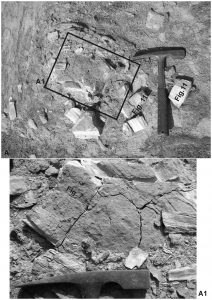 Thanks to financial support from the Center, we established a brand new lab focused on analogue tectonic experiments. The lab is equipped with highly sophisticated apparatus purpose-made by the Development Center of the Institute of Organic Chemistry and Biochemistry, Czech Academy of Sciences, which will be able to simulate a wide range of geologic processes, mostly related to active continental margins and subduction of oceanic plates.
Thanks to financial support from the Center, we established a brand new lab focused on analogue tectonic experiments. The lab is equipped with highly sophisticated apparatus purpose-made by the Development Center of the Institute of Organic Chemistry and Biochemistry, Czech Academy of Sciences, which will be able to simulate a wide range of geologic processes, mostly related to active continental margins and subduction of oceanic plates.
Author Archives: Jiri Zak
Development of an Ordovician trilobite was more variable than in its later relatives
 New discoveries in trilobite research: a large sample of developmental stages of trilobite genus Dalmanitina from the Ordovician of the Prague Basin allowed Lukáš Laibl and his colleagues to describe ontogeny of basal members of the suborder Phacopina. Adult phacopines are recognised by their fused facial sutures, which in other trilobites are non-fused and used during the moulting process. This means that rather than molting through the sutural gape mode, characterized by opening of the facial sutures and separation of the librigenae, adult phacopines disarticulated the entire cephalon in so called Salter’s mode of molting. Early developmental stages of Phacopina, however, moulted by sutural gape mode because they retained unfused facial sutures. The fusion of facial sutures occured during the postembryonic development and its developmental timing was intraspecifically fixed in most of the members of the group. However, this was not the case for Dalmanitina as in this genus facial suture fusion occurred variably in ontogeny. This confirms the hypothesis that basal members of major clades have less contrained developmental programs. The material also provides insight into how linked morphologies and behaviors evolved, potentially suggesting the timing of facial suture fusion in Phacopina moved earlier during development and became more intraspecifically fixed over geological time.
New discoveries in trilobite research: a large sample of developmental stages of trilobite genus Dalmanitina from the Ordovician of the Prague Basin allowed Lukáš Laibl and his colleagues to describe ontogeny of basal members of the suborder Phacopina. Adult phacopines are recognised by their fused facial sutures, which in other trilobites are non-fused and used during the moulting process. This means that rather than molting through the sutural gape mode, characterized by opening of the facial sutures and separation of the librigenae, adult phacopines disarticulated the entire cephalon in so called Salter’s mode of molting. Early developmental stages of Phacopina, however, moulted by sutural gape mode because they retained unfused facial sutures. The fusion of facial sutures occured during the postembryonic development and its developmental timing was intraspecifically fixed in most of the members of the group. However, this was not the case for Dalmanitina as in this genus facial suture fusion occurred variably in ontogeny. This confirms the hypothesis that basal members of major clades have less contrained developmental programs. The material also provides insight into how linked morphologies and behaviors evolved, potentially suggesting the timing of facial suture fusion in Phacopina moved earlier during development and became more intraspecifically fixed over geological time.
Drage H.B., Laibl L., Budil P. (2018): Postembryonic development of Dalmanitina, and the evolution of facial suture fusion in Phacopina. Paleobiology 44, 638-659 (DOI)
Continental margins in transition: how did northern Gondwana change from subduction to a shelf?
 New U-Pb detrital zircon ages obtained in collaboration with Goethe University (Frankfurt am Main, Germany) and Czech Academy of Sciences from siliciclastic rocks of the Central Bohemian Massif document an intriguing example of how protracted and complex may be a transformation of an active plate margin, controlled by subduction of an oceanic plate, to a passive continental shelf. The northern rim of the supercontinent Gondwana underwent this transition during the late Neoproterozoic to Cambrian times. In their plate-tectonic reconstruction, Hajná et al. assigned a key role to obliquity of the oceanic subduction and impingement of a hot oceanic ridge into the deep sea trench, emhasizing the analogy with modern geotectonic settings.
New U-Pb detrital zircon ages obtained in collaboration with Goethe University (Frankfurt am Main, Germany) and Czech Academy of Sciences from siliciclastic rocks of the Central Bohemian Massif document an intriguing example of how protracted and complex may be a transformation of an active plate margin, controlled by subduction of an oceanic plate, to a passive continental shelf. The northern rim of the supercontinent Gondwana underwent this transition during the late Neoproterozoic to Cambrian times. In their plate-tectonic reconstruction, Hajná et al. assigned a key role to obliquity of the oceanic subduction and impingement of a hot oceanic ridge into the deep sea trench, emhasizing the analogy with modern geotectonic settings.
Hajná J., Žák J., Dörr W., Kachlík V., Sláma J. (2018): New constraints from detrital zircon ages on prolonged, multiphase transition from the Cadomian accretionary orogen to a passive margin of Gondwana. Precambrian Research 317, 159-178. (DOI)
New fossils from the Seymour Island, Antarctica: a glimpse of Antarctic antiquity
 A new species of sessile barnacle Hexaminius venerai, described from the middle Eocene La Meseta Formation of Seymour Island, Antarctic Peninsula, is now the earliest known record of the genus in the Antarctic, its first occurrence from outside Australian waters, and the first record of a fossil cirripede attached to the substrate from the Antarctic. Exceptional preservation of more than 200 specimens revealed intriguing evolutionary aspects, suggesting that this species is a survivor of an early phase in balanid radiation, prior to the development of strong radially-interlocked parietes.
A new species of sessile barnacle Hexaminius venerai, described from the middle Eocene La Meseta Formation of Seymour Island, Antarctic Peninsula, is now the earliest known record of the genus in the Antarctic, its first occurrence from outside Australian waters, and the first record of a fossil cirripede attached to the substrate from the Antarctic. Exceptional preservation of more than 200 specimens revealed intriguing evolutionary aspects, suggesting that this species is a survivor of an early phase in balanid radiation, prior to the development of strong radially-interlocked parietes.
Kočí, T., Vodrážka, R., Kočová Veselská, M., Buckeridge, J. (2018): An intertidal balanomorph Hexaminius venerai sp. nov. (Austrobalanidae) colonizing a log of Podocarpoxylon from the La Meseta Formation (Eocene), Seymour Island, Antarctica: a glimpse of Antarctic antiquity. Historical Biology in press. (DOI)








